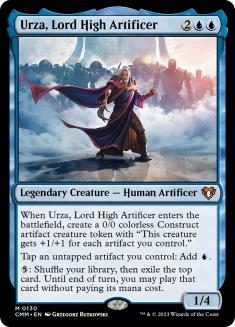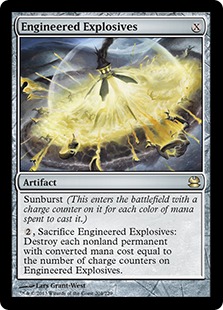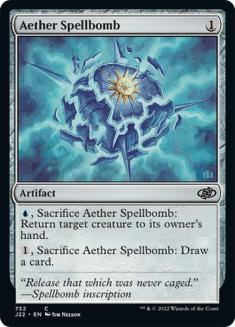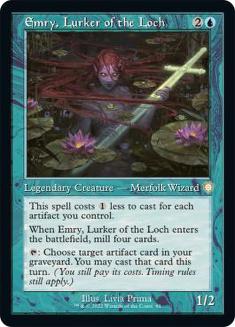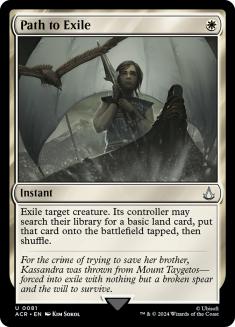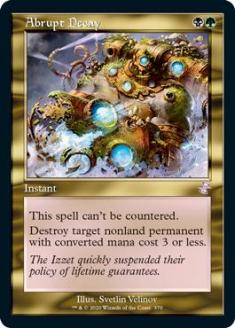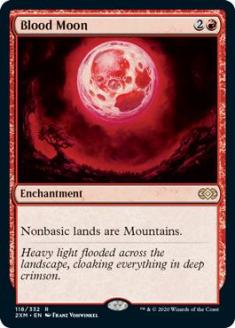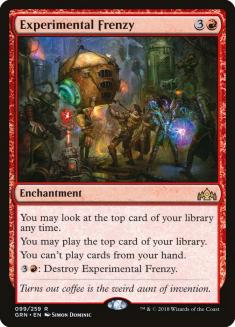If you’ve been paying attention to Modern recently, you’ve probably noticed that Urza, Lord High Artificer decks are everywhere. Right now, I think it would be journalistic malpractice to recommend any other deck for your next Modern tournament. A typical list is full of R&D mistakes: Oko, Thief of Crowns; Mox Opal; Gilded Goose; Mishra’s Bauble; Mystic Sanctuary; Emry, Lurker of the Loch; and, of course, Urza himself.
Most of the time, when a new archetype gains popularity, the hivemind quickly converges on a small number of stock lists with few flex slots. But Urza has so far resisted all attempts at such uniformity. To the contrary, the archetype seems to splinter into more and more variants with each passing event. In this article, I will examine every possible build of Urza and discuss what I would play at SCG Knoxville or Grand Prix Austin this weekend.
The Core
- 4 Gilded Goose
- 4 Oko, Thief of Crowns
- 4 Urza, Lord High Artificer
- 4 Mox Opal
- 4 Arcum’s Astrolabe
- 4 Mishra’s Bauble
- 2 Engineered Explosives
While a lot of the Urza deck is flexible, these 26 spells appear in every midrange Urza list I’m aware of. Oko and Urza are two of the most powerful proactive value-generating cards in Modern, and they both benefit greatly from the acceleration of Gilded Goose/Mox Opal and from having random artifacts like Arcum’s Astrolabe lying around. Even without many Emry in the deck, some Explosives are needed to help turn on fast Mox Opals and to act as a flexible interactive element, so they round out the foundation.
The Emry Package
Creatures (13)
Planeswalkers (4)
Lands (20)
Spells (23)

When the fairer Simic Urza lists first rose to prominence, every list had four copies of Emry and four copies of Engineered Explosives. But as time went on, people began trimming both cards, culminating in VTCLA’s MOCS winning list which played only a single Emry and two copies of Engineered Explosives. The reason for this change is largely that the cards have been a victim of their own success. The prospect of recursive maindeck Engineered Explosives forced the swarm decks most vulnerable to it out of the metagame entirely. The primary victims of this shift are Affinity and Humans, which no longer see as much play.
To push back against Urza, people moved instead to spell-based aggressive decks like Burn, Infect and Prowess that were less vulnerable to Explosives due to their speed and limited battlefield presence. Ramp decks like Simic Titan, TitanShift and Amulet Titan also took some of the available metagame share. Against the ramp decks, Engineered Explosives is only worthwhile against Amulet of Vigor, although it does have fringe application suppressing Field of the Dead tokens. Emry is somewhat useful for drawing cards against ramp strategies, although games tend to be about assembling pressure plus disruption and Emry offers neither.
The main alternative to Explosives is Aether Spellbomb. It answers opposing Urza tokens, and saves your creatures from removal and elking. It also does a great job dealing with Reality Smasher and Gurmag Angler and is responsible for a significant number of wins against Devoted Druid and Infect. In matchups where it’s otherwise ineffective, Aether Spellbomb also acts a repeatable source of card draw when combined with Emry. This card does so much that it easily pushes out non-Explosives competitors such as Witching Well.
At this point you may be wondering, why not just play four copies of Aether Spellbomb? I think the main problem is that ultimately, Engineered Explosives costs zero and turns on Mox Opal, better fueling the rest of the deck. There are a lot of hands where if your Spellbomb was an Explosives, you would get to cast a Turn 1 Emry or a Turn 2 Oko. Since those cards generate advantage every turn they are on the battlefield, the acceleration can easily be the difference between winning and losing. As a result, I currently favor a two-two split between Spellbomb and Engineered Explosives.
The argument in favor of playing large numbers of Emry boils down to a single matchup: the mirror. With both players having access to abundant countermagic, it is difficult to resolve the more expensive threats. However, since Urza decks typically don’t have much removal, a cheap threat that provides advantage each turn is exactly what the doctor ordered. The more of the mirror you expect, the more Emrys you should play. At the moment, I expect the winners metagame to contain a lot of Urza, and thus I want to play a lot of Emry.
That said, creature removal is not very popular in Modern at the moment and Emry is legendary, meaning I only want to draw about one copy per game. I also think that while Emry is amazing, the alternatives for those slots are also excellent, and I generally prefer to have access to a diversity of effects. This makes Emry almost the definition of a three-of.
The Splash Color
There have been successful Urza builds playing every possible splash. In a deck with Arcum’s Astrolabe, Mox Opal and Gilded Goose, the cost for doing so is simply minuscule. Blue and green are undoubtedly the strongest colors in Magic at the moment, but if there’s one thing they can’t do, it’s efficiently remove creatures from the battlefield. While this is not particularly important against ramp decks or the mirror, it’s critical against fast combo decks like Infect and Devoted Druid. Spot removal is also good against decks with large creatures such as Eldrazi Tron and Death’s Shadow and decent against Burn and Mono-Red Prowess. Since it isn’t particularly good against the mirror or big mana decks, most spot removal will be in the sideboard, but it’s an important part of the deck nonetheless.
White
Creatures (11)
Planeswalkers (5)
Lands (20)
Spells (24)

Path to Exile is the best spot removal spell against Reality Smasher and Gurmag Angler. It also dodges Veil of Summer, making it slightly better than alternatives against Devoted Druid. But the extra land isn’t worth it against red decks, where other removal would do just as well. Against Infect, the extra land is even more relevant, but this is mostly a wash as Infect has access to Veil of Summer too.
White also offers access to Teferi, Time Raveler. Teferi, which much like Oko, is practically unbeatable if you cast it quickly in the mirror. It’s a little weaker than Oko while behind, but overall I think it still helps there. Teferi also prevents Infect from protecting their creatures whatsoever, and bounces Chalice of the Void. He also supplements Path as a great way to deal with Reality Smasher and Gurmag Angler. Unfortunately, Teferi is almost dead against ramp decks and too slow to be effective against red decks.
On the whole, I think the white splash is amazing if you expect a lot of Death’s Shadow and Eldrazi Tron, but worse than alternatives otherwise.
Black
Creatures (12)
Planeswalkers (4)
Lands (20)
Spells (24)

Last weekend, Team Lotus Box came with their own spin on the Urza archetype. The black splash has Fatal Push in place of Path to Exile. Push can realistically come in for the mirror and is much better against red decks. However, its weakness to larger creatures and Veil makes it roughly equal on the whole. Note also that black can also mitigate its weakness to larger creatures with Assassin’s Trophy in the sideboard, as Edgar does in the list above.
The big gain for the black splash is the ability to maindeck Abrupt Decay. The most important card in the mirror by far is Oko, and if one player has Oko and the other doesn’t the game will rapidly spiral of control. Most lists are well-equipped to fight the planeswalker on the stack, but totally incapable of removing once it resolves. That means that if your opponent has a Turn 2 Oko and you are tapped out or don’t have a Mystical Dispute, the game is just over. Decay changes that dynamic.
The fact that Decay can hit noncreatures also makes maindecking it more justifiable. For instance, Eldrazi Tron’s creatures do not offer many good Decay targets, but getting Chalice off the battlefield is often a big swing. It also offers maindeck spot removal against everything from Burn to Devoted Druid, though it’s a little inefficient.
Thoughtseize improves the mirror match further by breaking up your opponent’s fast Oko draws and letting you navigate around their counterspells with ease. It’s also just generally effective against every non-Burn deck in the format.
Overall, I think black is the best of the builds in the mirror, but the maindeck Decays and increased vulnerability to Veil of Summer make it the weakest against ramp decks. I also think that the lack of any three-mana haymaker such as Teferi or Blood Moon makes it slightly weaker against Infect.
Red
Creatures (12)
Planeswalkers (4)
Lands (19)
Spells (26)

The red Urza builds include Galvanic Blast as their removal spell of choice. Blast is less effective than Abrupt Decay in the mirror, but it still does a reasonable job of taking down Oko. The fact that it goes to the face against ramp decks allows it to be maindecked, which offers all of the advantages I discussed above. In sideboard games, Galvanic Blast is mostly a Fatal Push that is immune to Veil, which is valuable but not exceptional.
Red also allows access to Blood Moon. Against the current crop of Primeval-Titan-based ramp strategies, this card ends the game for the bargain basement price of three mana. Non-red builds can utilize Ashiok for a similar effect, but Ashiok has to come down before lands like Field of the Dead and Valakut, the Molten Pinnacle enter the battlefield. Blood Moon is often lights out even when it’s topdecked.
In addition, Blood Moon is far more versatile than Ashiok. Against Infect, it stops Inkmoth Nexus cold and hamstrings their ability to double-spell by limiting their green mana. Blood Moon also is capable of locking Eldrazi Tron out of colorless mana entirely and will shut off their mana engine even if they find a Wastes.
The downside of Blood Moon is that it can sometimes make it difficult to cast Cryptic Command and will frequently lock you out of Mystic Sanctuary. Overall, it’s definitely better than Ashiok, but these small downsides make it less appealing relative to other splashes.
Do not play this card.
As you can see, the list Corey Baumeister team played above also features Experimental Frenzy in place of Cryptic Command. I think Corey and company are amazing players, but I also think they’re incredibly wrong on this one. In the mirror match, expensive haymakers are easily countered and generally are not that impressive. Against ramp decks, Cryptic Command is crucial for countering Titans, but also capable of winning otherwise out-of-reach games after Titan resolves. The tap mode is invaluable in a shell that can easily turn resolved Titans into Elk. Frenzy, on the other hand, will usually not be fast enough to avoid dying to a large number of triggers from Field of the Dead and Valakut, the Molten Pinnacle.
All of that said, there’s no reason playing red implies playing Frenzy. If I were going to play a red build, I would simply play Galvanic Blast and Blood Moon and call it a day. With that configuration, I think red is the best of any of the builds against ramp decks and Infect. However, it sacrifices percentage in the mirror relative to the black build.
The Decklist
Creatures (11)
Planeswalkers (4)
Lands (20)
Spells (25)

This weekend, I’m going to play the black splash. If your goal is to succeed in a tournament, the winners metagame is far more important than the Round 1 metagame. While I expect various ramp decks to be popular, I think most of the strongest players will play Urza and I also think Urza is a better deck. As a result, I think the winners metagame will be mostly mirror matches and Abrupt Decay gives me the best chance in those.


